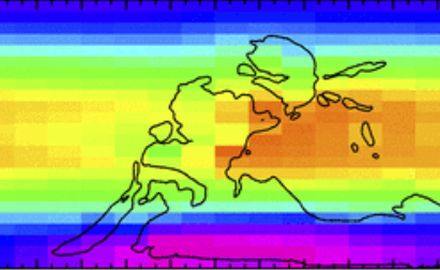Formation of coal almost turned our planet into a snowball

Annual mean temperature map for latest-Carboniferous temperatures for 150 ppm of CO2 and a cold orbital configuration, with reconstructed contours of continents. Fig. 2 of Feulner et al (cutout) Source: PIK
“It is quite an irony that forming the coal that today is a major factor for dangerous global warming once almost lead to global glaciation,” says author Georg Feulner from the Potsdam Institute for Climate Impact Research. “However, this illustrates the enormous dimension of the coal issue. The amount of CO2 stored in Earth’s coal reserves was once big enough to push our climate out of balance. When released by burning the coal, the CO2 is again destabilizing the Earth system.”
The study examines the sensitivity of the climate in a specific period of Earth’s deep past by using a large ensemble of computer simulations. While some of the changes in temperature at that time can clearly be attributed to how our planet’s axis was tilted and the way it circled the sun, the study reveals the substantial influence of CO2 concentrations.
Estimates based on ancient soils and fossil leaves show that they fluctuated widely and at some point sank to about 100 parts CO2 per million parts of all gases in the atmosphere, and possibly even lower. The model simulations now reveal that global glaciation occurs below 40 parts per million.
Burning that same coal dangerously raises greenhouse gas concentration in our atmosphere
Today, CO2 levels in the atmosphere have reached more than 400 parts per million. Carbon dioxide acts as a greenhouse gas: the Sun warms Earth’s surface, but most of the heat radiated by the surface escapes into space; CO2 and other greenhouse gases hinder part of this heat from escaping, hence warming the planet.
“We should definitely keep CO2 levels in the atmosphere below 450 parts per million to keep our climate stable, and ideally much lower than that. Raising the amount of greenhouse gases beyond that limit means pushing ourselves out of the safe operating space of Earth,” says Feulner. “Earth’s past teaches us that periods of rapid warming were often associated with mass extinction events. This shows that a stable climate is something to appreciate and protect.”
Article: Feulner, G. (2017): Formation of most of our coal brought Earth close to global glaciation. Proceedings of the National Academy of Sciences (PNAS)
Weblink to the article once it is published: http://www.pnas.org/
Registered journalists can access the article on Eurekalert: https://www.eurekalert.org/emb_releases/2017-10/potn-cap100417.php
For further information please contact:
PIK press office
Phone: +49 331 288 25 07
E-Mail: press@pik-potsdam.de
Twitter: @PIK_Climate
www.pik-potsdam.de
Media Contact
More Information:
http://www.pik-potsdam.deAll latest news from the category: Earth Sciences
Earth Sciences (also referred to as Geosciences), which deals with basic issues surrounding our planet, plays a vital role in the area of energy and raw materials supply.
Earth Sciences comprises subjects such as geology, geography, geological informatics, paleontology, mineralogy, petrography, crystallography, geophysics, geodesy, glaciology, cartography, photogrammetry, meteorology and seismology, early-warning systems, earthquake research and polar research.
Newest articles

NASA: Mystery of life’s handedness deepens
The mystery of why life uses molecules with specific orientations has deepened with a NASA-funded discovery that RNA — a key molecule thought to have potentially held the instructions for…

What are the effects of historic lithium mining on water quality?
Study reveals low levels of common contaminants but high levels of other elements in waters associated with an abandoned lithium mine. Lithium ore and mining waste from a historic lithium…

Quantum-inspired design boosts efficiency of heat-to-electricity conversion
Rice engineers take unconventional route to improving thermophotovoltaic systems. Researchers at Rice University have found a new way to improve a key element of thermophotovoltaic (TPV) systems, which convert heat…



